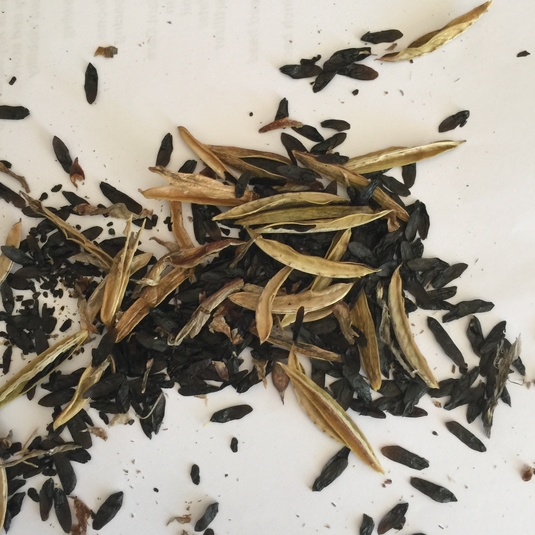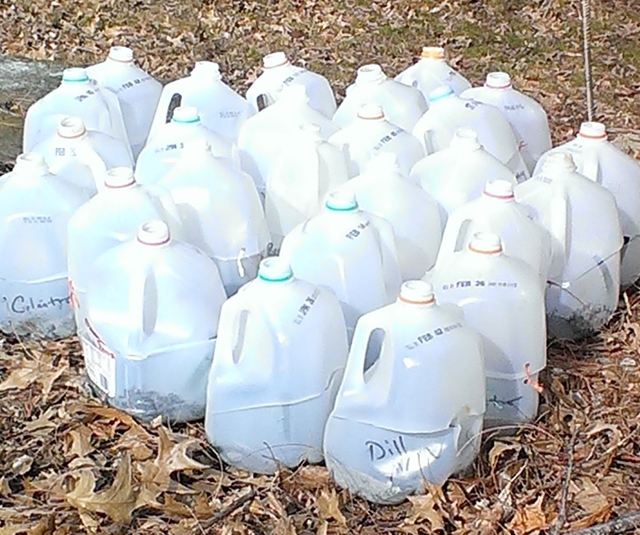Growing Hostas From Seed
So you're wondering, can I grow a hosta from seed? Growing hostas from seed is a tricky endeavor, but if you have patience and keep a few things in mind, it can be worth your time.
First, it's important to remember that hostas will not come true from seed. The hosta plant that you grow from seed will most assuredly be very different than the hosta you harvested the seeds from.
Not every hosta will produce seed pods, some will produce them in large numbers, others produce pods but very few seeds. Sometimes the seeds are not viable and will not germinate. Some hostas are completely pod sterile. There are varieties that are rather reluctant pod producers with a few seeds that are viable.
For a list of hosta cultivars that have seed pods that have been reported to be sterile or are reluctant seed producers, go to: HostaLists - Sterile Hostas
The Basics of Hosta Seeds
- Seeds from a blue or gold hosta produce blue, green and gold hosta seedlings.
- Seeds from a streaked or variegated hosta may give you a hosta with streaks but odds are they won't. However, pods that have stripes will have viable streaked seeds inside.
- Seeds from a green hosta will only produce a green seedling with the same or different characteristics.
- Seeds from a white hosta are not very viable at all.
- If there is a specific hosta that you'd like to get seeds from, be sure to water it well throughout the season for its best chance at forming seeds.
Hori-Hori Knife Great item for dividing perennials like hostas!
So if you want a hosta just like the one you have taken the seeds from, there is no way to do that from seed. The only way to get a hosta of the same variety is to divide the hosta.
So if you're adventurous and still want to give it a try, read on:

Harvesting the Seeds
The Seed Pods
Harvesting the Seeds
Green pods growing at the end of the hosta stem means that the flower has been pollinated. About 30 days after pollination, the hosta seeds should be ready to harvest.
As a rule, early-emerging hostas take longer to fully ripen their seeds. It may take over six weeks. Sometimes the pods that form in June aren't ready to harvest until September.
When the pod has turned brown or black and has dried out, the pods will begin to split lengthwise. That's a great time to harvest them.
In colder climates, though, the pods may not get to that point before the first frost. One way to harvest the seeds in those climates is to collect the green pods and place them in a paper bag to further dry out. But the general rule is to leave them on the plant as long as you can.
The seeds inside the pods will be black and papery, and viable seeds will have a noticeable bump on the end of the papery sleeve.
You are able to use the hosta seeds as soon as they're harvested.
If you need to store them, though, you can store the thoroughly-dried seeds in a plastic Ziplock bag until you're ready to use them. The seeds will only be viable for one year.
Sowing Hosta Seeds
Recommendations to hedge your bets on germination.
- USE FRESH SEEDS. (Within a year of harvesting.)
- Stratify the seeds before you sow them. This process improves the germination rate for all perennials, but it isn't necessary. A short visit to the refrigerator for two or three weeks will fool the seeds into thinking they have gone through the freeze/thaw cycle.
- A general seed starting mix is fine. If you want to mix your own, use some peat moss to hold moisture, and Perlite, bark, and grit to make the soil loose enough for those tiny roots.
- Thoroughly wet the soil before sowing the seeds as not to dislodge them later.
- Sow the hosta seeds thickly. Germination rates for hosta seeds are notoriously low.
- Sow them early. Hostas grow slowly at first. If hosta seeds are started indoors in January or February, they should be a good size to transplant outside by May giving them plenty of time to grow strong before you plant them out.
- Hostas do not need light to germinate. You can cover the seeds with 1/4” soil, or just gently tamp down the seeds so they connect to the soil.
- Spritz the top of the soil with a squirt bottle on the soft setting several times a day. The soil will need to be constantly moist from when sown to when the hostas have a few leaves.
- Cover your seed tray with a dome to retain moisture. If the soil dries out, the seeds will not germinate. Check daily to make sure the soil is moist but not wet. Lift the lid when necessary to avoid condensation. Once the first leaves appear, you can gradually remove the cover.
- Heat. Putting the container on the top of a refrigerator is enough to keep the tray warm. A seed heating mat is always ideal, but remove it once the seedlings appear to prevent root rot.
Be patient. It can take hosta seeds seven days to a few weeks to germinate.
Be patient. It can take hosta seeds seven days to a few weeks to germinate.
Hosta Seedling Care
- Bottom watering is always preferred. This lets the seedlings drink up the water they need without the roots being dislodged by pouring from the top.
- Use a fan on a light setting to strengthen the hosta seedlings' roots.
- Do not fertilize the seedlings until the four-leaf stage, then every two weeks with fertilizer at one-fourth strength.
Try Audible and Get Two Free Audiobooks
Potting Up Hosta Seedlings
At the four-leaf stage, you can transplant each one of your seedlings into a small two-ounce cup to grow on, then later into a four-ounce cup.
Hosta seedlings thrive on frequent transplantings, so you can do this as much as you like until they're ready to go outside.
The Great Outdoors
Lastly, slowly introduce your hosta plants to the outside weather by gradually setting them outside for longer and longer periods over a few weeks.
~~~~~~~~~~
Enjoy your new hosta adventure!
~~~~~~~~~~

Have You Tried Winter Sowing??
If you haven't tried winter sowing, you're in for a treat. This method is especially good for sowing herbs. Winter sowing is basically sowing seeds in the bottom of milk jugs in the winter, setting the milk jugs outside for the winter and leaving them there until the seeds germinate in the Spring.
For our article containing detailed information about Winter Sowing, click here.
To watch our 30 minute video on how to winter sow, click here.
Where to go next!




.png)






Has anyone ever used an aerogarden to start hostas?
ReplyDeleteHi, thanks for the article! Wondering how long it would take to grow a hosta from seed to full size?
ReplyDeleteTo mature, full size, up to four years depending on the variety of hosta.
DeleteThank you so much for your blog about planting hostas by seeds. I really want to give it a try! Do you think it would work to do winter sowing with hosta seeds? I am in zone 4, cold MN winters, warm to hot summers. Can you show me a few photos of how big the seedlings are at first? I'm so excited!
ReplyDelete